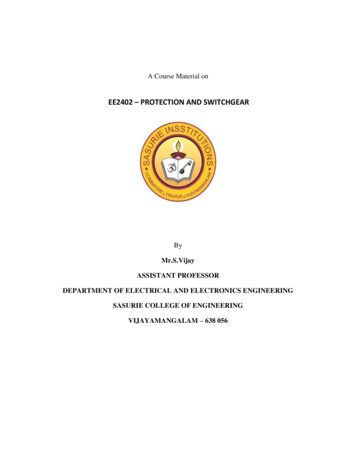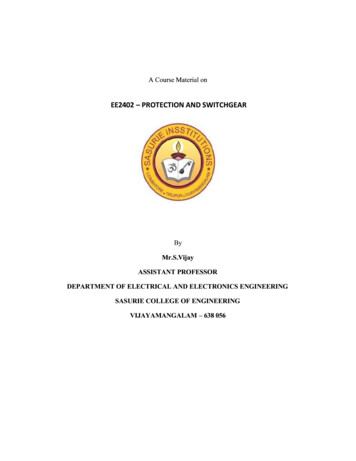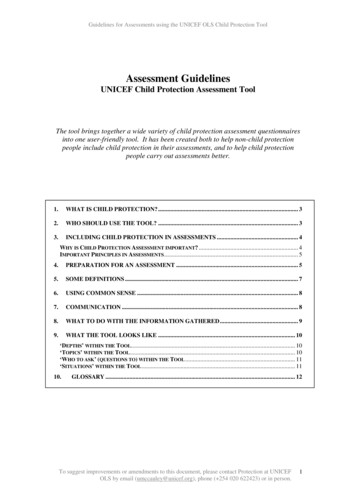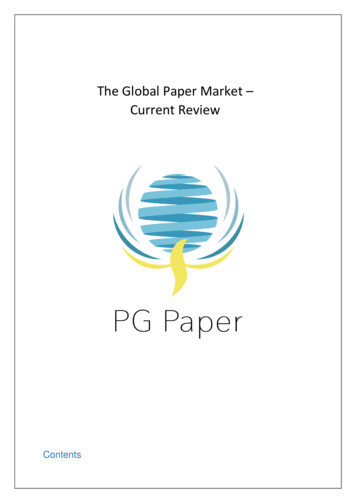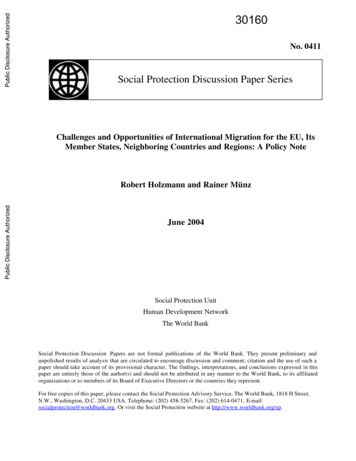
Transcription
Public Disclosure AuthorizedPublic Disclosure AuthorizedPublic Disclosure Authorized30160No. 0411Social Protection Discussion Paper SeriesChallenges and Opportunities of International Migration for the EU, ItsMember States, Neighboring Countries and Regions: A Policy NoteRobert Holzmann and Rainer MünzJune 2004Public Disclosure AuthorizedSocial Protection UnitHuman Development NetworkThe World BankSocial Protection Discussion Papers are not formal publications of the World Bank. They present preliminary andunpolished results of analysis that are circulated to encourage discussion and comment; citation and the use of such apaper should take account of its provisional character. The findings, interpretations, and conclusions expressed in thispaper are entirely those of the author(s) and should not be attributed in any manner to the World Bank, to its affiliatedorganizations or to members of its Board of Executive Directors or the countries they represent.For free copies of this paper, please contact the Social Protection Advisory Service, The World Bank, 1818 H Street,N.W., Washington, D.C. 20433 USA. Telephone: (202) 458-5267, Fax: (202) 614-0471, E-mail:socialprotection@worldbank.org. Or visit the Social Protection website at http://www.worldbank.org/sp.
Challenges and Opportunities of InternationalMigration for the EU, Its Member States, NeighboringCountries and Regions: A Policy Note*The World BankHuman Development NetworkSocial Protection HubHamburg Institute of International EconomicsMirgation Research GroupRobert Holzmann, Rainer Münz***This booklet is based on a paper presented at the 2nd Stockholm Workshop on GlobalMobility Regimes (June 11-12, 2004). It emerged from discussions between the World Bank andservices of the European Commission as well as from discussions with a larger number of scholarsand senior civil servants active in the fields of migration and development. Our work profited from highquality support by Johannes Köttl (School of Advanced International Studies, Johns HopkinsUniversity, and University of Vienna). The many inputs, suggestions, and critiques from World Bankcolleagues in different sectors and the main concerned regions (Middle East and North Africa, Europeand Central Asia) and from a number of academic scholars and senior civil servants are gratefullyacknowledged. The text, however, does not necessarely reflect the the view of the Hamburg Instituteof International Economics or the World Bank, its management or the Board of Executive Directors.**Robert Holzmann (director, Human Development Network, World Bank), Rainer Münz(Senior Fellow, Migration Research Group, Hamburg Institute of International Economics).Correspondence email address of the authors: Rholzmann@Worldbank.org; rainer.muenz@hwwa.de
AbstractThe policy note aims at identifying key challenges and opportunities for futuremigration policy, including win-win solutions that would allow sending and receivingcountries in and around Europe to benefit most from geographic mobility of people.The note1. highlights demographic, economic and political gaps explaining internationalmigration;2. explores the main options for the EU member states and reviews the expereincesof traditional countries of immigration;3. investigates the implications of a pro-active recruitment approach, including theimpacts on both sending and receiving countries;4. discusses development implications for sending countries;5. sketches the institutional requirements and necessary changes to move towardwin-win solutions, identifying areas of potential cooperation between sending andreceiving countries.The policy note concludes with a short summary and an outlook on open questions.i
Table of ContentsExecutive SummaryPart I Background and Options1 The Challenges of Demographic, Economic, and Political Gaps2 Migration: An Important Issue for the EU, Its Member States, and NeighboringCountries3 Main Options4 The Experiences of Traditional Countries of ImmigrationPart II Becoming Proactive5 Proactive Recruitment—a Problem for the EU in Need of Reframing?6 Impact on Receiving Countries7 Impact on Sending CountriesPart III Institutional Requirements and Changes to Move toward Win-WinSolutions8 Areas for Review in Receiving Countries9 Areas for Review in Sending Countries10 Areas of Cooperation between Sending and Receiving Countries for Win-WinSolutionsPart IV Conclusions and Implications11 Conclusions12 Agenda for Further Research and AnalysisBibliographyData SourcesAnnex: Figures and Tablesii
Executive SummaryThis paper aims at identifying key challenges and opportunities, including win-winsolutions that would allow sending and receiving countries in and around Europe tobenefit most from geographic mobility of people. The mission of the World Bank ispoverty reduction with a focus on economic and social development in low andmiddle income countries, the Bank’s client countries. This development focus alsodetermines the approach for this text on international migration. Formulating mutuallybenefiting strategies, however, requires also the identification of interests andpotential advantages of migration for high income countries, the Bank’s sponsorcountries. To this end the text seeks a balanced approach in the identification ofchallenges and opportunities for both sending and receiving countries of migrationflows. The note provides a framework for further consideration and research but notfirm answers to the issues raised.Today Europe is home or host to a fifth of the world’s migrant population. Thisalmost equals the size of the foreign-born population in the US. Migration to Europe –mostly originating from the geographic vicinity – is related to major economic,demographic and political gaps between the EU and neighboring regions. While theEU is a relatively wealthy and politically stable world region with an aging andeventually shrinking population, neighboring countries to the south and southeast aremuch poorer and politically less stable, but have young and growing populations. Inthis situation migration from the poorer but demographically growing to the richer butdemographically stagnating societies is almost inevitable. The first question thereforeis how to manage – not how to prevent – migration to Europe.In any case such migration might be in the interest of sending countrieswanting to reduce pressure on their labor markets and to avoid the underutilization ofskills. Sending countries also have a growing interest in remittances generated bytheir migrant diaspora. For some countries such remittances have become a majorsource of capital. At the same time such migration may be in the interest of the EUand its member states as a means to reduce current and future shortages of laborand skills.Migration should be seen as a partial answer to both surplus labor supply insending countries and aging and eventually shrinking domestic work forces inEurope. Migration can only play such a role if Europe is able to attract migrants withneeded skill levels; and if these migrants have access to formal labor markets. Tothis end Europe will have to develop a comprehensive migration policy thatincorporates selection and admission procedures for people who qualify for economicreasons as temporary migrants or as permanent immigrants. Europe might also be inneed of unskilled migrants. And Europe may have to pay more attention to thedevelopment of skills and qualifications in potential sending countries: for example byco-financing parts of the education system. This may counterbalance possiblenegative effects for sending countries linked to brain drain.Experiences of traditional countries of immigration – in particular Australia,Canada and New Zealand – should be analyzed and adapted. In this context the EUand its member states also have to review and improve measures and rightsfacilitating the integration of long-term migrants and arrangements regulating accessof migrants to social security benefits and services such as education and health.1
Higher attention should also be paid to the transferability of social insurance andbenefits of migrants who return to their countries of origin, in particular health andpension benefits.A permanent dialogue between the EU and sending countries could explorethe possibility of cooperation in various migration-related fields. In principle sendingand receiving countries have a common interest to explore win-win solutions thatallow not only the countries and economies involved but also the migrantsthemselves to gain from geographic mobility of labor and skills. Issues for such adialogue could be joint border management, agreements on visa regimes and laborpermits, orderly departure and safe travel arrangements, living and workingconditions of migrant workers and permanent immigrants, brain drain and skillformation, transferability and portability of claims towards social security, dualcitizenship, channels and average costs of remittances. Such migration-relatedissues might also become elements of future trade, cooperation and associationagreements between the EU and third countries.All attempts to develop and implement coherent migration regimes as well asintegration and citizenship policies need public support among domestic populationsand polities of sending and receiving societies. It is therefore necessary to explainwhy and how shaping – not preventing – future migration to Europe, influencing thecomposition of the migrants, and incorporating those who will – and should – stay foran extended period of time can be managed in the best interest of both migrants andEuropeans themselves.2
Part I Background and Options1The Challenges of Demographic, Economic, and PoliticalGapsEurope1 is home or host to 36-39 million international migrants, about 8 percent of itspopulation.2 Some 33–35 million migrants have taken up residence in one of the 15states that constituted the EU until recent enlargement (EU 15). The 10 new memberstates host about 1.5 million permanent or long-term residents who are foreign born.3In absolute terms, Europe’s immigrant population is about the same size as thenumber of immigrants in the United States. Europe has become one of the maindestinations on the world map of international migration. From a historicalperspective, this is a relatively new phenomenon.After having been primarily countries of emigration for more than twocenturies, during the last 50 years, all countries of Western Europe gradually becamedestinations for international migrants (table 3). Several of the new EU memberstates in Central Europe also follow that pattern.4 The Czech Republic, Hungary,Slovakia, and Slovenia already have a positive migration balance (table 4). It is verylikely that, sooner or later, this will be the case in other new EU member states. ManyEuropeans, however, still do not see their homelands as destinations for immigration.Today, this contrafactual perception of demographic realities has become anobstacle to the development and implementation of proactive migration regimes.International migration is certainly increasing on a global scale (see table 5),and the causes and underlying processes that have led to this shift from emigrationto immigration in Europe are manifold. The most important causes are related to theconsiderable economic, social, and political imbalances that characterize the gapbetween relatively rich, democratic, and stable but aging societies in Europe and themuch poorer, less stable, but youthful and demographically growing societies inneighboring and other world regions.1.1Demographic Imbalances1. Defined as the EU-25; Iceland, Liechtenstein, and Norway (European Economic Area[EEA]); and Switzerland, with 467 million inhabitants (table 4).2. Official statistics in many European countries do not consider population by place of birthbut by citizenship. Naturalized immigrants are therefore not always statistically “visible,” and nativeborn children with foreign citizenship remain in the “foreigner” category if at birth they acquire onlytheir parents’ citizenship. In the decade 1992-2001 some 5,855,000 people were naturalized in EU 15(OECD/ Sopemi 2004). Bringing them into the picture is crucial in order to fully understand thequantitative impact of migration and to analyze the social and economic status of Europe’s immigrantpopulation. Table 1 in the annex details the stock of legal foreign residents and statistically identifiedimmigrants (i.e. foreign-born residents) in EU 15 according to various data sources; table 2 showsforeign labor in absolute numbers and as a percentage of the total labor force in selected Europeancountries. For a detailed analysis of migrants and legal foreign residents in EU 15 see Münz andFassmann (2004).3. About 1.7 million migrants live in Liechtenstein, Norway, and Switzerland.4. The new EU member states in Central Europe and the Mediterranean have a totalpopulation of 74 million.3
Europe’s demographic situation is characterized by low fertility, an increasing lifeexpectancy, and overall by a projected shrinking of populations in the decades tocome. This contrasts with the neighboring south and southeastern regions, wherefertility is much higher, albeit declining, life expectancy is also increasing, and overallpopulation is projected to continue to grow at a high pace. Low fertility and increasinglife expectancy in Europe both reverse the age pyramid, leading to a shrinkingnumber of younger people, an aging work force, and an increasing number andshare of older people.5 According to Eurostat data and projections by the UnitedNations, Western and Central Europe’s6 total population size will remain stableduring the next 20 years (2000: 464 million, 2003: 467 million, 2025: 466 million) andstart to decrease only during the following decades (by 2050, 442 million). But in theabsence of massive recruitment of economically active migrants, the number ofpeople between ages 15 and 64 will decrease from 312 million (2000) to 295 million(or –5.5 percent) until 2025 and to 251 million (–19.6 percent) by 2050.During the same period, the number of people older than 65 in Western andCentral Europe will increase from 73 million (2000) to 104 million by 2025 ( 42.5percent) and then at a slower pace to 125 million in 2050 ( 71.0 percent). As a resultthe old age dependency ratio (population 65 /population 15-65) is likely to increasefrom 23 percent (2000) to 35 percent (2025) and 45-50 percent (2050).The situation in Eastern Europe, the Balkans, Turkey, and Central Asia(EECA-20)7 is similar to the one in the EU-25. In the EECA-20, the population willalso remain stable during the next 25 years (in 2000, 405 million; by 2025, 407million) and then start to decrease during the following decades (by 2050, 381million; –6.2 percent). Continuing population growth is expected for Azerbaijan,Turkey, and most parts of Central Asia, but most Balkan countries, Russia, andUkraine face considerable demographic decline.8 In the EECA-20, the number ofpeople between ages 15 and 64 will slightly increase from 270 million (in 2000) to277 million in 2025 ( 2.6 percent) and then rapidly decrease to 235 million (–13percent) in 2050.In contrast, the situation in Europe’s southern and southeastern neighbors (theMiddle East, North Africa, and the Gulf states [MENA-20])9 is characterized byhigher—but declining—fertility, rising life expectancy, and sustained demographicgrowth. Total population in the MENA-20 will grow steadily from 316 million in 2000to 492 million by 2025 ( 55.7 percent) and to 638 million by 2050 ( 102.0 percent).During this period, the number of people between ages 15 and 64 will more thandouble, from 187 million in 2000 to 323 million by 2025 ( 72.7 percent) and continueto grow at almost the same rate to 417 million by 2050 ( 123.0 percent).5. For an illustration of projected population changes across regions and age groups, seefigures 1 and 2.6. The 28 EU EEA countries and Switzerland.7. The EECA-20 countries consist of Albania, Armenia, Azerbaijan, Belarus, BosniaHercegovina, Bulgaria, Croatia, Georgia, Kazakhstan, Kyrgyz Rep., Macedonia, Moldova, Romania,Russian Fed., Serbia-Montenegro (including Kosovo), Tajikistan, Turkey, Turkmenistan, Ukraine,Uzbekistan; see table 7.8. Some EECA-20 countries—for example, Armenia, Bulgaria, and Romania—already have adeclining population.9. The MENA-20 countries consist of Algeria, Bahrain, Djibouti, Egypt, Iran, Iraq, Israel,Jordan, Kuwait, Lebanon, Libya, Morocco, Oman, Palestinian Territories (West Bank and Gaza),Qatar, Saudi Arabia, Syria, Tunisia, United Arab Emirates, Yemen; see table 7.4
At the same time, this region also faces an aging problem. Its population overage 65 will grow from 13 million in 2000) to 31 million in 2025 ( 148.0 percent) and to82 million in 2050 ( 556.0 percent).101.2Labor ForceThe change in the economically active population, however, will be smaller than theprojected changes for the 15–64 age group, because only 60–80 percent of this agegroup are currently employed or self-employed (table 6). After 2010, Western andCentral Europe (the EU-25) can expect a decrease in the active population. Until2025, the decrease will be –16 million (figure 3). During the same period (2000–25),the active or job-seeking population will still increase by 7 million people in theEECA-20 and by 93 million in the MENA-20.11 In the EECA-20, this increase willmainly take place in Turkey and Central Asia; in countries such as Bulgaria, Serbiaand Montenegro,12 Moldavia, and Romania the active or job-seeking population isalready shrinking.Throughout the 21st century, Europe will be confronted with a rapidly shrinking(native) work force (–46 million until 2050; figure 4) while the potentially activepopulation will continue to grow in Europe’s southern and southeastern neighbors( 157 million until 2050 for the MENA-20) and in Turkey and parts of Central Asia(EECA-20 overall: –28 million until 2050; Turkey: 17 million; rest of EECA: -45million).For Europe the main challange is the changing ratio between economicallyactive and retired persons. With a projected employment rate of 70%, the number ofemployed persons per persons aged 65 and over will decline from 2.7 in 2010, tosome 2.2 in 2020, to 1.8 in 2030 and to only 1.5 in 2040. If, after reaching the socalled Lisbon target, the employment rate were to rise further to 75% between 2010and 2020, the decline in this ratio would be attenuated, reaching 2.4 in 2020In North Africa and the Middle East the main challenge is to absorb thosecurrently unemployed and those entering the labor market during the next twodecades. In order to fully cope with this challenge the MENA-20 countries wouldhave to create 45 million new jobs until 2010 and more than 100 million until 2025while Europe is confronted with choices concerning higher pensionable age, higherlabor force participation of women, and the recruitment of immigrants. The currentlabor market conditions in many MENA-20 countries raise doubts whether theseeconomies will be able to absorb the significant expansion of the labor force. As aconsequence of persistent, large-scale unemployment in many MENA-20 countries,migration pressures on the contracting labor markets in Europe will increase.10. Data from the United Nations Common Database.11. Data from authors’ own calculations, based on projections from the International LabourOrganisation (ILO) Economically Active Population database and United Nations Population Division(2003).12. Without Kosovo.5
1.3Economic ImbalancesEconomic indicators clearly show two things: the large gap between Europe andneighboring world regions, but also considerable heterogeneity within these regions.The maximum ratio of per capita income between the richest European and poorestMENA-20 country is 82:1; for the regional per capita averages, the ratio still amountsto almost 7:1.13In 2000, Western and Central Europe (the EU-25, the EEA, and Switzerland)had 465 million inhabitants, with an average per capita gross domestic product(GDP) US 19,000, ranging in Western Europe from US 42,000 (Luxembourg) toUS 11,000 (Portugal) and in the new EU member states from US 9,400 (Slovenia)to US 3,200 (Latvia). The EECA-20 region had 402 million inhabitants, with anaverage per capita GDP of US 1,600, ranging from US 4,600 (Croatia) and US 2,100–2,200 (Russian Federation, Turkey) to a mere US 170 (Tajikistan). TheMiddle East and North Africa in 2000 were home to 313 million people, with anaverage per capita GDP of US 2,600 per year. In the Gulf states, the average percapita GDP is close to European levels (US 11,000), but the region also compriseslow-income countries such as Morocco (US 1,200), Syria (US 1,100), and Yemen(US 500; see table 7).141.4Political Stability and Rule of LawPolitical, ethnic, or religious conflicts exist in all world regions compared in this note.But as asylum and displacement figures show, only some of these conflicts createmigration pressure, which explains, at least in part, the annual inflow of some400,000–450,000 people15 seeking asylum in Europe.16 A ranking of all EU EEA,EECA, and MENA countries according to a political stability indicator and a rule oflaw indicator may serve as a proxy for the level of individually perceived insecurity.17Despite all the possible imperfections in the constructions of such indicators, theexercise indicates differences in political stability, the human rights situation, and thegeneral rule of law between Europe and neighboring regions, with the EU countriesat the top of the score, most Eastern European and Balkan countries in the mediumrange, and many of the MENA countries in the lower segments.In Europe, all 25 EU member states are characterized by a high degree ofpolitical stability and a general rule of law. In contrast, the populations of severalcountries in the Balkans, the Caucasus, and Central Asia, as well as in North Africaand the Middle East, are confronted with some degree of political instability (or theprospects of such instability occurring) and no universal rule of law. This maysignificantly reduce individual security and hence impact the decision to remain in thecountry of origin or to emigrate. Besides the economic and demographic arguments,13. At current exchange rates.14. Data from the United Nations Common Database.16. For the last 14 years, the lowest figure was 260,100 (in 1996), the highest was 698,600 (in1992; see table 11).15. In 2000–03, Afghanistan, Iraq, the Russian Federation (in particular, Chechnya), Serbiaand Montenegro/Kosovo, and Turkey were the most important countries of origin of people seekingasylum in Europe. See United Nations High Commissioner for Refugees (2004)17. The expected value of the indicator across all countries worldwide is 0, with a standarddeviation of 1. For further information on how the indicator is constructed, see Kaufmann (et al. 2003).6
the political and human rights imbalance adds yet another dimension to suchdecisions and therefore has to be taken into account when considering the realities ofwider Europe’s current and future migration flows.1.5ConclusionsThese imbalances explain why Europe is and will continue to be a major destinationfor migrants, even in times of slow economic growth, high domestic unemployment inmany EU countries, and growing efforts to control and eventually reduce the inflow ofasylum seekers and regular and irregular labor migrants. In 2001 alone, some 1.47million new immigrants lawfully took residence or claimed asylum in one of the 15 EUmember states.18 On average, the annual net gain from migration of the EU-15 is justover 1 million people per year (about 2.2 per 1,000), which explains four-fifths ofEurope’s population growth (tables 3, 4).Even if economic conditions in the sending countries were to improve, oneshould not expect the economic push factors to disappear quickly. The current levelsof economic growth and job creation in sending countries in the wider Europe (inparticular, MENA and Central Asia) and other parts of the world with migratory linksto Europe (for example, Sub-Saharan Africa, South Asia) are not sufficient to absorbthe projected demographic growth and, in particular, growth of the labor force inthese countries. Large cohorts will try to enter the labor market during the comingyears, while unemployment and underemployment are already high.One also has to bear in mind that the majority of migrants either do not comefrom the lowest-income countries, but rather from the middle-income countries, orthey come from low-income countries but have a middle-class background. It seemsthat emigration only occurs once a certain level of development has been reached,which allows a first generation of potential emigrants to acquire the necessary meansfor leaving their home country. Therefore, a successful development process could inthe short run lead to an increase in migration rather than a decrease—the so-calledmigration hump—before having a lasting impact on the outflow of people.192Migration: An Important Issue for the EU, Its Member States,and Neighboring CountriesVarious reasons cause the countries in Europe’s vicinity to be the main sendingcountries and EU member states to be the main receiving countries. Key issues aresketched in this section and elaborated later in this note.2.1Trade, Capital Flows, and Migration16. See Organisation for Economic Co-operation and Development (2004).19. For an overview of current research and activities of relevant stakeholders on issues,causes and effects of international migration and international cooperation on migration issues, seeTamas (2003).7
Intensified trade relations, as in EU partnerships with neighboring and developingcountries, have been put forward as a substitute for interregional migration andindeed as a means of containing mass migration from poorer to richer countries. Infact, international economics textbooks describe trade, capital flows, and the mobilityof labor as (perfect) substitutes to achieve factor price equalization. Furthermore,increased trade is expected to lead to higher growth—in particular in poorercountries—and the ensuing economic convergence should reduce the incentives formigration. Yet research on trade and migration suggests that trade liberalization andmigration control are not substitute policies, at least not in the short term. On thecontrary, there are strong indications that both are complements, particularly if tradeliberalization happens between richer and significantly poorer countries.20 At leastinitially, migration pressure may surge or not be reduced substantially, as has beenshown by the aftermath of the North American Free Trade Agreement (NAFTA).21Furthermore, there are convincing claims that overall welfare gains from liberalizationof labor flows are expected to be far higher than any effects from full liberalization oftrade.2.2Brain Drain, Brain Gain, or Brain Waste?Data from the Organisation for Economic Co-operation and Development (OECD)suggests that 20–30 percent of all physicians in the United States, Canada, and theUnited Kingdom earned their degrees abroad—in the majority of cases, in developingcountries. These countries are estimated to supply more than 50 percent of allmigrating physicians but receive only a little more than 10 percent through returnmigration of former medical students educated in Europe and North America.22Analysis carried out by the World Bank also shows that by 2000, some 60 percent ofEast Asian adults living in the United States had attended college or graduate schoolin their home country.23 This could be seen as a substantial subsidy by sendingcountries’ publicly funded education systems for more developed receiving countries.However, it has been argued that the anticipation of such opportunities couldincrease the number of people interested in higher education. Because many of themultimately do not emigrate, human capital formation could be stimulated.24It is as yet undecided whether and under what conditions internationalmigration causes brain drain that is detrimental to the economic and socialdevelopment of particular sending countries or under what conditions it leads tocirculation of skills, their improvement, and eventual later return while highunemployment at home would lead to a considerable underuse of these skills andtherefore eventually to “brain waste.” Whatever the actual results are, certain sendingcountries and nongovernmental organizations have accused receiving countries of“skimming off” skills while severely damaging certain sectors of sending countries—inparticular, the health care sector.20. Faini (et al. 1999).21. See Papademetriou (2004).22. See OECD (2002).23. See Lucas (2001).24. See Stark (et al. 1998).8
For a certain number of countries, it could be argued that the emigration ofskilled people ultimately leads to higher remittances that more than compensate forthe net loss. Recent estimates for India suggest that in 2001, fiscal loss due toemigration amounted to a maximum of 0.6 percent of Indian GDP, and the total valueof remittances equaled 2.1 percent of GDP.252.3RemittancesRemittances are a core topic related to international migration, and the World Bankas well as the Hamburg Institute of International Economics are actively engaging inresearch to document both the magnitude and the direction of flows and to determinethe impact of remittances on development. An assessment of documented flowsshows their substantial increase during the 1990s (table 8 and figure 10) andindicates that their total volume has become substantially larger than the combinedtotal of public and private official development assistance (ODA).Empirical evidence suggests that remittances have a positive impact onpoverty reduction.26 Some of the EU’s main foreign labor sources (countries such asTurkey, Tunisia, Morocco, a
4. discusses development implications for sending countries; 5. sketches the institutional requirements and necessary changes to move toward win-win solutions, identifying areas of potential cooperation between sending and receiving countries. The policy note concludes with a short summary and an outlook on open questions.






